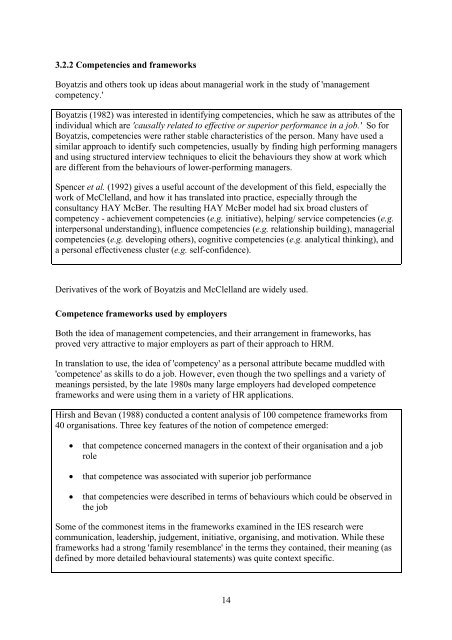The Development of Management and Leadership Capability and its ...
The Development of Management and Leadership Capability and its ...
The Development of Management and Leadership Capability and its ...
Create successful ePaper yourself
Turn your PDF publications into a flip-book with our unique Google optimized e-Paper software.
3.2.2 Competencies <strong>and</strong> frameworks<br />
Boyatzis <strong>and</strong> others took up ideas about managerial work in the study <strong>of</strong> 'management<br />
competency.'<br />
Boyatzis (1982) was interested in identifying competencies, which he saw as attributes <strong>of</strong> the<br />
individual which are 'causally related to effective or superior performance in a job.' So for<br />
Boyatzis, competencies were rather stable characteristics <strong>of</strong> the person. Many have used a<br />
similar approach to identify such competencies, usually by finding high performing managers<br />
<strong>and</strong> using structured interview techniques to elicit the behaviours they show at work which<br />
are different from the behaviours <strong>of</strong> lower-performing managers.<br />
Spencer et al. (1992) gives a useful account <strong>of</strong> the development <strong>of</strong> this field, especially the<br />
work <strong>of</strong> McClell<strong>and</strong>, <strong>and</strong> how it has translated into practice, especially through the<br />
consultancy HAY McBer. <strong>The</strong> resulting HAY McBer model had six broad clusters <strong>of</strong><br />
competency - achievement competencies (e.g. initiative), helping/ service competencies (e.g.<br />
interpersonal underst<strong>and</strong>ing), influence competencies (e.g. relationship building), managerial<br />
competencies (e.g. developing others), cognitive competencies (e.g. analytical thinking), <strong>and</strong><br />
a personal effectiveness cluster (e.g. self-confidence).<br />
Derivatives <strong>of</strong> the work <strong>of</strong> Boyatzis <strong>and</strong> McClell<strong>and</strong> are widely used.<br />
Competence frameworks used by employers<br />
Both the idea <strong>of</strong> management competencies, <strong>and</strong> their arrangement in frameworks, has<br />
proved very attractive to major employers as part <strong>of</strong> their approach to HRM.<br />
In translation to use, the idea <strong>of</strong> 'competency' as a personal attribute became muddled with<br />
'competence' as skills to do a job. However, even though the two spellings <strong>and</strong> a variety <strong>of</strong><br />
meanings persisted, by the late 1980s many large employers had developed competence<br />
frameworks <strong>and</strong> were using them in a variety <strong>of</strong> HR applications.<br />
Hirsh <strong>and</strong> Bevan (1988) conducted a content analysis <strong>of</strong> 100 competence frameworks from<br />
40 organisations. Three key features <strong>of</strong> the notion <strong>of</strong> competence emerged:<br />
• that competence concerned managers in the context <strong>of</strong> their organisation <strong>and</strong> a job<br />
role<br />
• that competence was associated with superior job performance<br />
• that competencies were described in terms <strong>of</strong> behaviours which could be observed in<br />
the job<br />
Some <strong>of</strong> the commonest items in the frameworks examined in the IES research were<br />
communication, leadership, judgement, initiative, organising, <strong>and</strong> motivation. While these<br />
frameworks had a strong 'family resemblance' in the terms they contained, their meaning (as<br />
defined by more detailed behavioural statements) was quite context specific.<br />
14
















